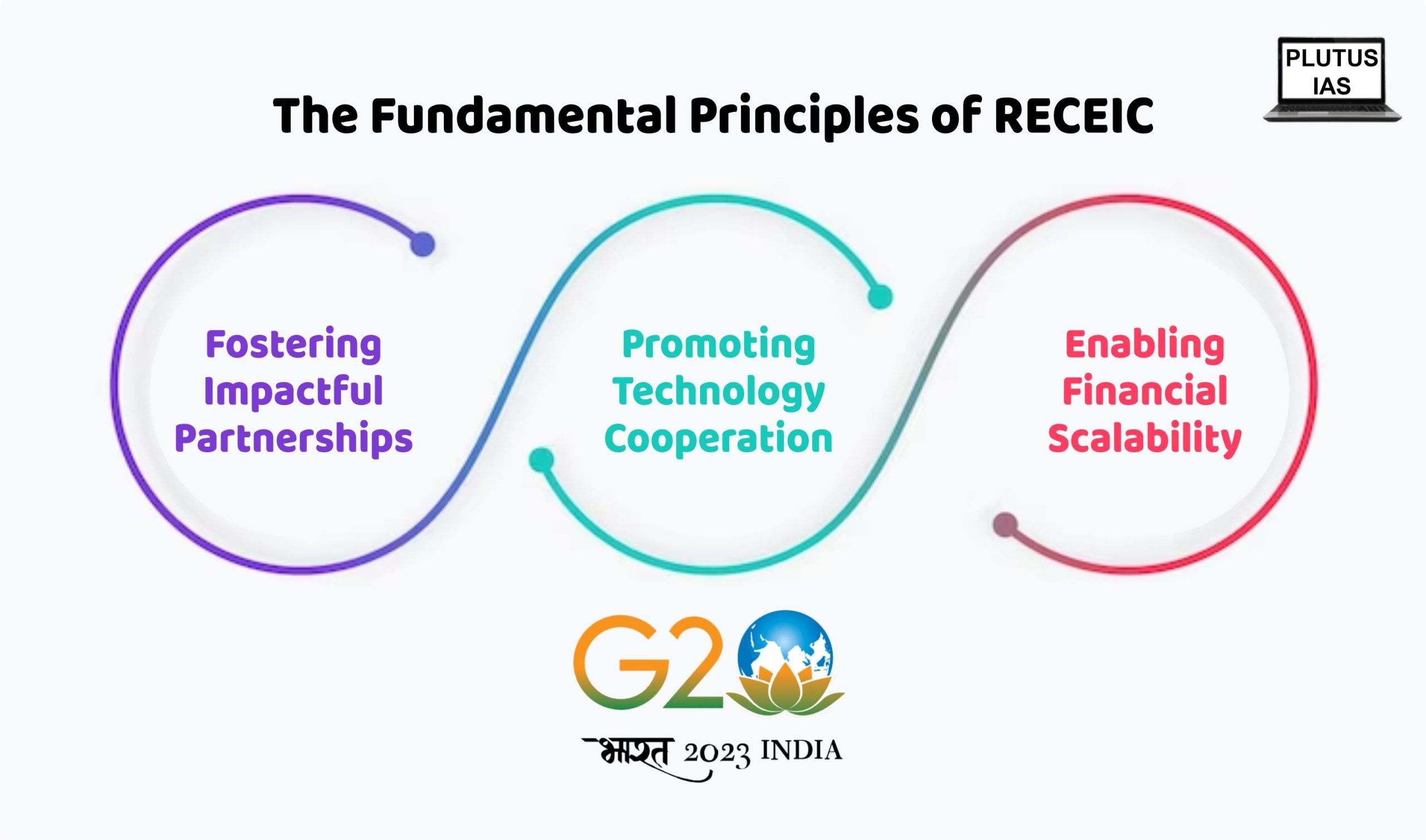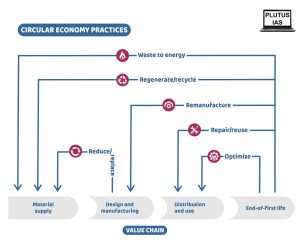31 Jul Resource Efficiency Circular Economy Industry Coalition (RECEIC)
This article covers “Daily Current Affairs” and the topic details “Resource Efficiency Circular Economy Industry Coalition (RECEIC)”. The topic “Resource Efficiency Circular Economy Industry Coalition (RECEIC)” has relevance in the “Economy” section of the UPSC CSE exam.
For Prelims:
What is the Resource Efficiency Circular Economy Industry Coalition (RECEIC)?
What is Circular Economy?
For Mains:
GS2: Economic Development, Environment
Why in the news?
The Resource Efficiency Circular Economy Industry Coalition (RECEIC) was launched on the sidelines of the 4th G-20 Environment and Climate Sustainability Working Group (ECSWG) and Environment and Climate Ministers’ meeting in Chennai. The coalition aims to promote resource efficiency and circular economy practices in the G-20 countries.
What is RECEIC?
-
- The Coalition, conceptualised by India’s G20 Presidency, is expected to be an industry-driven and self-sustaining initiative that will continue to function even after India’s G20 Presidency ends.
- The coalition comprises “39 original members representing 11 different countries.” The main purpose of RECEIC is to serve as a platform for exchanging knowledge and best practices, encouraging sustainable approaches within its participating industries.
- The fundamental principles of RECEIC centre on
- fostering impactful partnerships
- promoting technology cooperation
- enabling financial scalability
- Their aim is to tackle environmental issues arising from waste, encompassing areas such as plastics, microplastics, e-waste, and chemical waste.
- The launch of RECEIC included the signing of the foundational charter and the unveiling of the coalition’s logo. Dignitaries from seven countries, including Mauritius, Denmark, Italy, Canada, UAE, France, and the European Union, participated in the event.

Circular Economy
The circular economy is a production and consumption model that emphasizes various practices to maximize the use of existing materials and products, aiming to extend their life cycle and minimize waste.
Key Principles:
- Sharing: Encouraging the sharing of resources and products among multiple users to optimize their utilization.
- Leasing: Promoting leasing or rental services for products, enabling multiple users to benefit from a single item’s functionality.
- Reusing: Emphasizing the reuse of products or materials in their original form for as long as possible.
- Repairing: Encouraging the repair and maintenance of products to extend their useful life and prevent premature disposal.
- Refurbishing: Upgrading or renovating products to give them a new life and improve their functionality.
- Recycling: Collecting and processing materials from discarded products to create new items or inputs for other industries.

Contrasting the Linear Economic Model
- Traditional Approach: The linear economic model follows a linear path of take-make-consume-throw away, leading to excessive resource consumption and waste generation.
- Challenging Planned Obsolescence: The circular economy opposes planned obsolescence, where products are intentionally designed with a limited lifespan to stimulate frequent replacements.
Benefits of Transitioning to a Circular Economy
Environmental Protection:
- Reducing Resource Usage: By reusing and recycling products, natural resource consumption is minimized, curbing landscape disruption and habitat destruction.
- Combating Climate Change: Circular practices contribute to lower greenhouse gas emissions, as industrial processes and waste management are significant emission sources.
Reduced Raw Material Dependence:
- Addressing Finite Supplies: With a growing global population, circularity helps mitigate the risks associated with limited raw materials.
- Mitigating Import Dependency: Recycling raw materials domestically reduces reliance on imports, stabilizing supply chains and mitigating price fluctuations.
Job Creation and Consumer Savings:
- Fostering Economic Growth: Transitioning to a circular economy promotes innovation, making industries more competitive and supporting economic growth.
- Job Opportunities: Job creation is stimulated, with estimates suggesting hundreds of thousands of new jobs in the EU alone by 2030.
- Enhanced Consumer Experience: Durable and innovative products lead to improved quality of life for consumers and long-term cost savings.
Government Initiatives to Promote Circular Economy:
- Policy Formulation: Government has introduced rules like Plastic Waste Management, e-Waste Management, Construction and Demolition Waste Management, and Metals Recycling Policy to address waste management and resource utilization.
- NITI Aayog’s Efforts: NITI Aayog has initiated projects for sustainable economic growth, waste utilization, promoting industrial by-products’ usage, and organizing conferences on sustainable growth through recycling.
- Strategic Collaboration: NITI Aayog, along with ministries, has prepared resource efficiency strategy papers for sectors like steel, aluminum, construction, demolition, and e-waste, aiming to transition towards a circular economy.
- Committee Formation: 11 committees, led by concerned ministries, officials, experts, and industry representatives, have been established to develop action plans for implementing circular economy practices in their focus areas.
The circular economy presents a sustainable and economically viable alternative to the linear consumption pattern. Emphasising reuse, recycling, and responsible production practices, it offers environmental protection, resource efficiency, and economic benefits for individuals and society as a whole. By adopting this model, we can work towards a greener and more prosperous future.
Sources:
39 MNCs come together for circular economy coalition – The Hindu
plutus ias current affairs eng med 31st July 2023
Q1. With reference Resource Efficiency Circular Economy Industry Coalition (RECEIC), consider the following statements:
- RECEIC is an industry-driven and self-sustaining coalition aimed at promoting resource efficiency and circular economy practices in G-20 countries.
- The RECEIC initiative is solely driven by India’s G20 Presidency, and its existence is expected to end after India’s presidency term concludes.
- The coalition aims to focus solely on environmental issues related to waste, such as plastics, microplastics, e-waste, and chemical waste.
Which of the statements given above is/are NOT correct?
(a) 1 and 2 only
(b) 2 and 3 only
(c) 3 only
(d) None
Answer: (b)
Q2. Consider the following :
- The circular economy opposes planned obsolescence, which involves intentionally designing products with a limited lifespan to encourage frequent replacements.
- Transitioning to a circular economy leads to a decline in job opportunities and economic growth, as it discourages innovation.
- Transitioning to a circular economy primarily benefits businesses and industries with little impact on consumers.
How many of the abovementioned statements are correct ?
(a) Only one
(b) Only two
(c) All three
(d) None
Answer: (a)
Q3. Examine the role of the circular economy in addressing environmental challenges, and discuss how RECEIC can contribute to tackling these issues.



No Comments